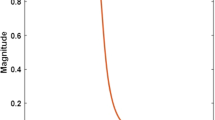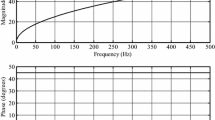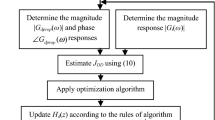Abstract
Our initial research work was focussed on employing metaheuristic optimization techniques to design optimal digital signal processing (DSP) systems such as the full band, conventional infinite impulse response differentiators and integrators meeting the accurate magnitude responses with a smaller average group delay. Since, integer order systems are a tight subset of the fractional order (FO) systems the research has been extended towards the optimal design of FO differentiators and integrators in the discrete domain with improved frequency response performances. Specific emphasis was laid on the feasibility of the designed FO differentiators in controlling a double-integrator plant. Analogue Butterworth filter with fractional stepping in the transition band has also been realized using an optimal integer-order rational transfer function. In future, we intend to design and implement generalized fractional-order filters on FPGA/DSP kit and FPAAs.
Similar content being viewed by others
Explore related subjects
Discover the latest articles, news and stories from top researchers in related subjects.Avoid common mistakes on your manuscript.
1 Introduction
The major research areas explored in the past 2 years are:
-
(a)
Design of integer-order digital differentiators and integrators;
-
(b)
Design of fractional-order (FO) digital differentiators and integrators; and
-
(c)
Design of fractional-order analogue filters such as the fractional order Butterworth filter (FOBF).
In the following sections, a brief outline of our major achievements for each of the three research areas is presented.
2 Optimal design of conventional digital differentiators and integrators
The application of traditional discrete-time differentiators and integrators is well-known in the field of digital control systems (e.g., digital PID controller), biomedical signal processing (e.g., QRS complex detection of ECG signal), image processing (e.g., detection of edges for the digital images), and communication systems (e.g., radars). The major findings which have been published by us in [1,2,3] have employed various evolutionary algorithms to optimally design wideband IIR discrete-time filter approximations of the conventional integrators and differentiators exhibiting an accurate magnitude response with a lower average group delay. To reduce the computational complexity and data latency for real-time signal processing applications, the orders of the proposed designs are restricted between one to four. Compared to the existing literature, issues associated with the s-domain to z-domain discretization operation are eliminated in our proposed works. A comparison of the proposed hybrid flower pollination algorithm (HFPA) based digital differentiator (DD) of order two published in [3] with the recent literature [4, 5] in terms of the absolute magnitude error (AME) is shown in Fig. 1 to demonstrate the improved accuracy of the proposed method. While the maximum AME (MAME) for the DDs in [4, 5] are 9.80 dB and − 27.67 dB, respectively, the same for our HFPA-based proposed design [3] is − 30.14 dB.
Comparison of the absolute magnitude error (AME) responses for the proposed HFPA-based DD [3] of order 2 with the recent literature
For the proposed HFPA-based DDs of order 3, MAME of − 32.18 dB is achieved in comparison to − 22.69 dB achieved by the MPSO-based technique reported in [5]. Similarly, the proposed HFPA-based digital integrator (DI) of order 3 achieves a MAME of − 41.92 dB and an average group delay of 0.50 samples which outperforms the DD reported in [5] where MAME of − 25.97 dB and average group delay of 2.51 samples were reported.
In future, the practical realizations of these DD/DI models will be conducted on a field programmable gate array (FPGA) boards and DSP kits also the proto type will be fabricated for some typical applications.
3 Optimal design of wideband fractional-order digital differentiators and integrators
An ideal fractional order differentiator/integrator (FOD/FOI) is characterized by infinite dimensions, and its frequency response is given by (1).
where r is the fractional-order of the FOD/FOI, r∈(0,1) for the FOD and r∈(− 1,0) for the FOI, and ω is the angular frequency in radians per second (rad/s). Thus, the magnitude and phase responses of the ideal FOD/FOI are given by (2) and (3), respectively.
IIR rational models for the wideband FODs and FOIs are designed using state-of-the-art evolutionary algorithms. The major publications in this field by the author are cited as [6,7,8,9,10]. From the viewpoint of the practical implementation, first to fifth orders of the filters are only realized. The effects due to the finite word length for the models are also evaluated by conducting robustness studies. The proposed design approach eliminates the need for a discretization operator.
Comparison in terms of absolute relative magnitude error (ARME) of the proposed adaptive g-best guided gravitational search algorithm (GGSA) [6] with the recent literature for the FOD of orders 3 and 5 are shown in Figs. 2 and 3, respectively.
Comparison of the absolute relative magnitude error (ARME) responses for the proposed GGSA-based FOD [6] of order 3 with the recent literature
Comparison of the absolute relative magnitude error (ARME) responses for the proposed GGSA-based FOD [6] of order 5 with the recent literature
The design and application of the optimal fractional order proportional integrator/derivative controller are also investigated in [6]. Special emphasis is laid on the feasibility of the designed fractional order differentiators in controlling a double-integrator plant in [6]. Figure 4 shows the unit step response for our proposed GGSA-based FOD published in [6] compared to the responses of the FODs in [11,12,13]. The fastest transient response and the best steady state performance is demonstrated by the proposed FOD.
Comparison of unit step responses for the GGSA-based FOD [6] of orde 5 for the half differentiator with the state-of-the-art for A = 1000 for the double integrator plant control system
The FOIs designed by the authors in [9, 10] using colliding bodies optimization (CBO) algorithm and symbiotic organisms search (SOS) algorithm, respectively, demonstrate an improved accuracy compared to state-of-the-art. Such FOIs may be used as building blocks for fractional order PI/PID controllers. Comparison of the absolute magnitude responses (AME) of the CBO-based FOI of order 3 for the half integrator compared to the PSO-based FOIs reported in [14, 15] are shown in Fig. 5. It is observed that the best response is obtained by our proposed design.
Comparison of the absolute magnitude error (AME) responses for the proposed CBO-based FOI [9] of order 3 with the recent literature
4 Optimal design of fractional order Butterworth filter
We have carried out the integer order rational approximations of the fractional step analogue filters such as the Butterworth filter [16,17,18] which provid precise control of stopband attenuation. While most of the literature presents the designs of such filters using a fractional order transfer function approximation, however, they can only be practically implemented by using fractance devices (such as the fractional order capacitors) which are commercially unavailable. Our proposed approach eliminates the need for such fractance devices to practically implement the fractional order analogue filters. The proposed approach will lead to the designs being realized practically using active components such as operational amplifiers and passive components such as resistors and capacitors. The design technique employs metaheuristic nature-inspired global search optimization algorithms instead of sub-optimal approaches proposed in the literature since the design optimization problem is a multimodal and non-uniform one.
The magnitude response of the proposed fractional Butterworth filter designed using gravitational search algorithm (GSA) published in [16] is shown in Fig. 6. The integer order, i.e., first and second order characteristics are also shown in Fig. 6 for comparison purposes. The fractional stepping beyond the cut-off frequency can be observed for the figure. Percentage improvements in terms of the passband error (PE) and stopband error (SE) metrics for GSA over genetic algorithm (RGA) and PSO based fractional order low pass Butterworth filter (FOLBF) also reported by the author in [16] are shown in Figs. 7 and 8, respectively.
Magnitude responses for the proposed GSA-based fractional order Butterworth filter [16]
PSPICE simulations have also been carried out for implementing the 1.2nd, 1.5th, 2.3rd, and 4.7th order FOLBFs. The magnitude responses of the simulated filters in comparison with the ideal filter are shown in Figs. 9, 10, 11, 12, respectively. It may be seen that the responses of the ideal and the proposed filter nearly overlap.
SPICE simulation results to demonstrate the Bode magnitude plot for the proposed 1.2nd order FOLBF published in [16]
SPICE simulation results to demonstrate the Bode magnitude plot for the proposed 1.5th order FOLBF published in [16]
SPICE simulation results to demonstrate the Bode magnitude plot for the proposed 2.3rd order FOLBF published in [16]
SPICE simulation results to demonstrate the Bode magnitude plot for the proposed 4.7th order FOLBF published in [16]
Hence, our proposed models in [16] are accurate alternatives to the state of the art literature [19,20,21] as demonstrated by percentage improvement plots in Figs. 13 and 14.
5 Conclusion
A generalized approach to determine the coefficients of the filters is being investigated. Simulations have demonstrated promising results in terms of both the pass band and the stop band characteristics of the designed filters. Once again, practical applications are kept in mind while designing the filters. The lower orders of the proposed designs will reduce the hardware overhead and data latency. In future, the implementations of the proposed models will be carried out on platforms such as field programmable analogue arrays in our lab.
References
Mahata S, Saha SK, Kar R, Mandal D (2017) Enhanced colliding bodies optimisation-based optimal design of wideband digital integrators and differentiators. Int J Bio-Inspired Comput 9:165–181
Mahata S, Saha SK, Kar R, Mandal D (2016) Optimal design of wideband digital integrators and differentiators using harmony search algorithm. Int J Numer Model Electron Netw Dev Fields. https://doi.org/10.1002/jnm.2203
Mahata S, Saha SK, Kar R, Mandal D (2018) Optimal design of wideband digital integrators and differentiators using hybrid flower pollination algorithm”. Soft Comput 22:3757–3783
Al-Alaoui MA (2011) Class of digital integrators and differentiators. IET Signal Process 5:251–260
Jalloul MK, Al-Alaoui MA (2015) Design of recursive digital integrators and differentiators using particle swarm optimization. Int J Circuit Theor Appl 44:948–967
Mahata S, Saha SK, Kar R, Mandal D (2017) Optimal and accurate design of fractional order digital differentiator—and evolutionary approach. IET Signal Process 11:181–196
Mahata S, Saha SK, Kar R, Mandal D (2018) Optimal design of fractional order digital differentiator using flower pollination algorithm. J Circuits Syst Comput 27:1–35
Mahata S, Saha SK, Kar R, Mandal D (2018) A metaheuristic optimization approach to discretize the fractional order Laplacian operator without employing a discretization operator. Swarm Evolut Comput. https://doi.org/10.1016/j.swevo.2018.06.007
Mahata S, Saha SK, Kar R, Mandal D (2016) Optimal design of wideband infinite impulse response fractional order digital integrators using colliding bodies optimisation algorithm. IET Signal Process 10:1135–1156
Mahata S, Saha SK, Kar R, Mandal D (2018) Optimal design of wideband fractional order digital integrators using symbiotic organisms search algorithm. IET Circuit Devices Syst 12:362–373
Rana KPS, Kumar V, Garg Y et al (2016) Efficient design of discrete fractional order differentiators using Nelder–Mead simplex algorithm. Circuits Syst Signal Process 35:2155–2188
Gupta M, Yadav R (2014) New improved fractional order differentiator models based on optimized digital differentiators. Sci World J 2014:1–11
Leulmi F, Ferdi Y (2015) Improved digital rational approximation of the operator sα using second-order s-to-z transform and signal modelling. Circuits Syst Signal Process 34:1869–1891
Gupta M, Yadav R (2013) Optimization of integer order integrators for deriving improved models of their fractional counterparts. J Optim 2013:1–11
Yadav R, Gupta M (2015) New improved fractional order integrators using PSO optimization. Int J Electron 102:490–499
Mahata S, Saha SK, Kar R, Mandal D (2018) Optimal design of fractional order low pass Butterworth filter with accurate magnitude response. Digit Signal Process 72:96–114
Mahata S, Saha SK, Kar R, Mandal D (2018) Accurate integer order rational approximation of fractional order low pass Butterworth filter using a metaheuristics optimization approach. IET Signal Process 12:581–589
Mahata S, Saha SK, Kar R, Mandal D (2018) Approximation of fractional-order low pass filter. IET Signal Process 12:123–145. https://doi.org/10.1049/iet-spr.2018.5128
Freeborn TJ, Maundy B, Elwakil AS (2010) Field-programmable analogue array implementation of fractional step filters. IET Circuits Devices Syst 4(6):514–524
Psychalinos C, Tsirimokou G, Elwakil AS (2016) Switched-capacitor fractional-step Butterworth filter design. Circuits Syst Signal Process 35(4):1377–1393
Freeborn TJ (2016) Comparison of (1 + α) fractional-order transfer functions to approximate low pass Butterworth magnitude responses. Circuits Syst Signal Process 35(6):1983–2002
Author information
Authors and Affiliations
Corresponding author
Rights and permissions
About this article
Cite this article
Kar, R. Optimal designs of analogue and digital fractional order filters for signal processing applications. CSIT 7, 175–180 (2019). https://doi.org/10.1007/s40012-019-00225-y
Received:
Accepted:
Published:
Issue Date:
DOI: https://doi.org/10.1007/s40012-019-00225-y


















